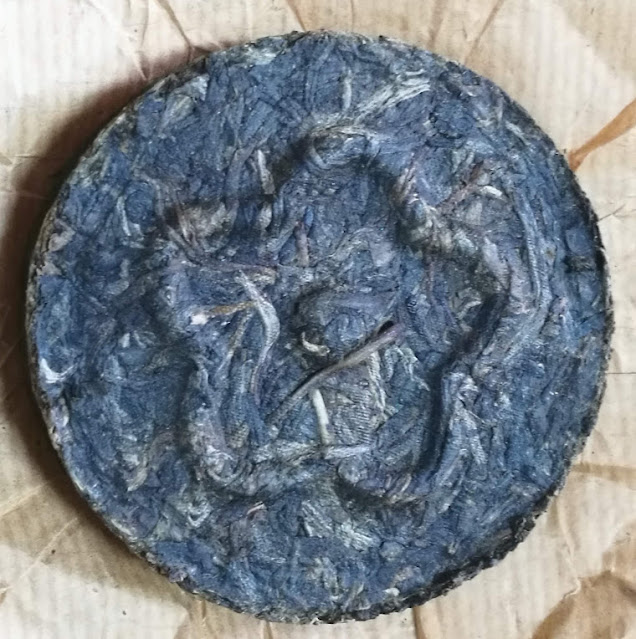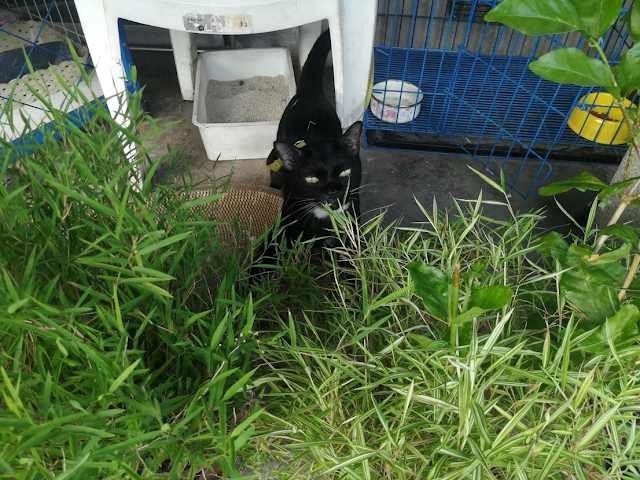 |
the Kokang version left, Mingdee right (in all photos) |
In visiting a local tea shop a couple of weeks ago, Ju Jen in the Paradise Park mall, a tea contact I was there to meet shared a few teas with me, including these. One is a 2016 Kokang Myanmar sheng, and the other a 2011 Mingdee Thai sheng. I have two other versions of Kokang sheng around, part of one cake (2018, that was) and two small older cakes (I think from the same producer).
Kokang is both an area in Myanmar and a producer name, if I've got that right. The category name of pu'er doesn't necessarily apply to these, being from Myanmar and Thailand, but they're the same type of tea, made from the same general type of plants, related Assamica versions.
Mingdee, the producer, rings a bell but I may have never tried any version from them. I think them and Wawee Tea might be the two main producers, but the subject of Thai sheng keeps such a low profile it's hard to be sure.
 |
that shop visit |
Review:
2016 Kokang Myanmar sheng: it's pleasant. It has picked up good warmth and depth in the last 7 years, for sure. The brighter floral notes are transitioned away but there is plenty to appreciate; complexity and balance are good. It seems as well to turn that into more of a list on the second round. Bitterness is non-existent but it will probably kick in more next round.
2011 Thai (Chiang Rai / Wawee) Mingdee: generally pleasant but this may be right in the in-between age transition place where teas tend to go a bit quiet. Pushing it later may help a little, but if it's at a point where former compound profile is half transitioned to different forms that may only go so far. Again checking on a list of aspect will probably go better next round.
Kokang, #2: nice! This range is familiar. Sweetness is good, and mineral base (in between light and warm, or maybe spanning both), with an earlier floral range (likely prominent earlier) now shifted to warmer tones, cedar wood, spice range, maybe a touch of warm dried fruit. Whether or not this is a relatively optimum aging level for drinking this could vary by preference.
The vendor sales page for the other Myanmar sheng I own (one of 3 versions) described it indirectly as good but not great, along the lines of typical for tea material like this. That was from Chawang Shop. Maybe this had slightly more complexity, intensity, and aging potential, so the other could be a little more faded at this point. It would've made more sense to compare this tea with that but I really wanted to try both of these, and I have a few other teas around to get to.
Mingdee: it's not bitterness that's ramping up but depth and mineral base really is. This is clean and complex, just not overly intense. I think it has great potential to age into a more subtle aged range, not the kind of tea that's still undrinkable after 12 years, but one that can finish transitioning in a few more, picking up more complexity in a different range.
Mineral depth is unusual in this, for being so heavy and warm in tone, and for dominating the rest of the flavor profile. I think that's partly an effect from the other flavors still shifting from younger to older form, so it seems quiet, because there is a broad range there, but all at a subtle level. As younger and brighter tones finish dropping out the deeper and warmer ones will be more evident. It might turn out like aged Yiwu sometimes does though, on the subtle side. Those can go further into flavorless, if not well-suited for aging, but some might just be subtle, or I suppose others yet more intense as aged sheng than I've experienced. I might have only ever tried a half dozen relatively fully aged Yiwu versions, so that sampling is too limited for broad generalizations.
Given that I'm reviewing 7 and 12 year old sheng versions the timing for this evaluation is a little off optimum; these would tell a more complete story in 5 more years. Those small 2006 Kokang mini cakes, are surely not ready even for being 17 years old, so I've not been re-trying them yet. That style seemed suitable for 25 years of aging, given how the hard pressed form will slow transition pace. I'll still try one over the next few years but it won't be ready yet.
Kokang, #3: there is definitely a very catchy flavor aspect that's common in Myanmar sheng, that I've not described here yet, and probably not done justice to pinning down elsewhere either. In a younger version one would naturally see it as floral + light mineral, but there's a little more to it. It might be a spice range sort of flavor, along the line of bay leaf. I've used bay leaves in cooking but not very often, so that's partly a guess, which conveys some general range.
Mingdee: this is still quite subtle but it's evolving in a positive way. Heavy mineral is still present but other range is balancing with that more now. It's more in an aged furniture range, a mix of aromatic wood tones and non-distinct aromatic oils. A bit of cedar wood dryness and edge joins that, but it's not dry in feel, it just has a dry component. Texture / feel will keep shifting over the next half-dozen years too.
Kokang #4: this keeps improving; that's always nice. Depth and the way it integrates gets better and better. That one hint of harder to define aspect seems to have a shifted to include a touch of lemon; it balances well with the rest. It doesn't have the richest feel, or much aftertaste at all, but the feel it does express is positive. There are no flaws, and the balance works; it's hard to place how those enter in as positive inputs.
Mingdee: maybe fading just a little, although that probably relates to variations in infusion time, which I don't track closely. There is nothing new to add. I have a couple of things to do so I'll try one more infusion and quit the notes, even though these aren't quite halfway finished yet. I'll steep a little longer so I'm not commenting that this is hard to place, which will probably shift results a little again.
Kokang #5: this is quite pleasant. That touch of citrus (lemon), light spice background, nice mineral base, mix of warmer and lighter tones all integrates really well. It could easily seem disjointed or at an awkward phase instead; maybe in another 2 or 3 years it will be like that. I'm not sure this has great aging potential, to be honest. Intensity is fine at this stage but as it swaps lighter for heavier range that may fade, and it's not that intense now, for a 7 year old sheng.
I might prefer to drink this particular tea aged 3 or 4 years, back when it hit a little harder, and retained more younger notes, but had lost a lot of it's more youthful challenging rough edges. It's good now though, I just don't know if it would be better or worse in 7 more years. There's a good chance it will fade (just a guess, of course).
Mingdee: more or less the same as it had been, mixing the same aspects described in earlier rounds, with proportion and overall effect not changing too much. At least this is really clean in effect; there are no flaws from storage inputs or original negative character. Limitations only seem to relate to what wasn't present initially, to the potential it had for aging.
I think this would be quite good in 5 or 6 more years, but that's only if someone likes subtle aged sheng, versions where intensity is quite low, and rich feel carries the weight of a lot of what you experience. The warm flavor tones and mineral base won't completely drop out but with this being limited in intensity as a 12 year old tea I'd expect it to be on the subtle side as an 18 year old version. Which is ok, if someone is really on that page.
It's more natural for me to prefer versions with lots more intensity that need a little more time to complete transition. Those sorts of "challenging when young" versions, that aren't quite there at 18 years old, develop great depth, good balance, complexity, and really interesting flavors, but only at closer to 25 years old.
For drinking at this stage it's still pleasant. That touch of dryness doesn't come across as overly negative, and the flavor balance isn't bad. It not being optimum relates to an imagined potential, not a real experiential gap, beyond what isn't in the cup right now.
 |
Myra visits while I do the tasting |
Conclusions:
It was interesting trying two very different tea versions, again. It's interesting how the much younger one worked better in the current aspects balance than the older version, per my preference. There is a common perception related to sheng pu'er that older is better. To me every version has an optimum transition level, but that can only be defined in relation to someone's individual preference.
For focusing mainly on aspects and only doing tangents on aging potential and likely earlier changes it seems like I've not fully addressed how much I like these. This style of Myanmar tea, and the distinctive aspects that seem tied to there, I really do like. Familiarity alone might make it more pleasant, and it fits in with what I've been drinking most and liking more recently. I drank half a small cake of that one related Myanmar tea about a year ago, a tea I took to Honolulu to drink regularly there. It's not tied back to the same producer, but very similar in character.
The other might seem somewhat related to all the Thai sheng I've been drinking, but the style was probably different to start, and I'm not regularly drinking any from a 12 year old age range. To me this probably isn't a completely ideal tea for long term aging, but then it probably wasn't in a very approachable when young style either, more in the middle. That doesn't make it bad, but it loses a little.
It may be at its best aged in the 16 to 18 year range, or at least relatively already peaked then, perhaps better yet at 25 to 30 years old, but also not so different. If this had spent more time in Bangkok it might be more fermented (transitioned) now, but to be clear I don't know where it stayed. It doesn't seem like it started as a very challenging version, so maybe not completely unlike the ones I drink now, or it would still have more for rough edges, beyond a bit of extra dryness. The North is still tropical but not as consistently hot and humid as here; not even close.
Both were pleasant and interesting to try. Both are much appreciated; it's nice having a local friend who shares teas like these.
 |
another small shop in Bangkok, off Soi 6 in Yaowarat (Chinatown), not related to this post |
 |
the market alley it's in |































